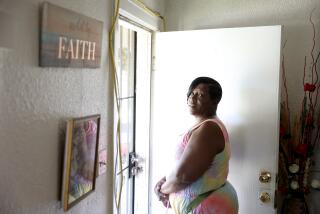County Agrees to More Foster Care Visits
After resisting for years, Los Angeles County officials are gearing up to ensure that social workers visit children in foster care at least once a month.
County Department of Children and Family Services officials said they will comply with a court order mandating the frequent visits that was recently upheld by the state Supreme Court after two years of legal battles with child-safety advocates.
About 50,000 abused and neglected children in the care of the county are covered by the order. Anita Bock, director of the department, said the change will be a “major reform journey.”
In the past, when social workers felt visits were unnecessary, they could get a waiver from a supervisor. The new rules mean that no waivers can be granted unless social workers submit a detailed report supporting the conclusion that the child is in a stable, safe environment, and a judge agrees.
The lawsuit, filed by the Alliance for Children’s Rights two years ago, maintained that social workers weren’t visiting foster children enough--as infrequently as every two years--and that waiver records were not kept, said Amy Pellman, executive director of the alliance.
County lawyers argued that filing reports would be a burden on 1,800 social workers. They said individual hearings could be scheduled if needed.
The department oversees more foster children than in any other county in the nation, followed by New York County (Manhattan) with about 32,000, according to the National Assn. of Counties.
Visiting children in foster care has become more of a concern nationwide, especially since 5-year-old Rilya Wilson of Miami was discovered missing a few weeks ago. She was last seen more than 15 months ago and is still missing. Her caseworker resigned after allegedly falsifying records to make it appear that she had been visiting the child regularly.
“The more eyes on these kids ... there’s a better chance abuse will not take place,” said Daniel Grunfeld, president of Public Counsel, which provides free legal assistance to children. “We’re dealing with the most vulnerable children of our community.”
Los Angeles County used to employ waivers to avoid visits more than any other county in the state, according to Alice Bussiere, a staff attorney with the Youth Law Center in Sacramento.
Two other counties, Alameda and San Francisco, were forced to reform after state audits showed that they too were lagging in the frequency of home visits, according to Larry Bolton, general counsel for the state Department of Social Services.
In Los Angeles County, restrictions on the use of waivers were recommended in 1998 by a blue-ribbon task force on foster care that was created after a spate of deaths of foster children. A county grand jury also criticized the practice, urging improvements in the way the agency tracked the well-being of children in its care.
Since the criticism and the lawsuit, Bock said, she has instituted sweeping changes in record keeping. Now quarterly reports are compiled. Waiver requests are reviewed by committees in each of the department’s eight regions and then considered by another panel after interviews with the child and foster family are conducted, Bock said. “The new process is a little labor intensive,” she said. “We had to go a little above and beyond what was necessary.”
Those changes have added a substantial amount of time to the process of reviewing waiver applications, Bock said. According to department records from October to December 2001, 69 waivers were in effect, a marked decline from before the lawsuit.
On May 15, the state Supreme Court rebuffed the county’s last appeal and declined to interfere with Los Angeles County Superior Court Judge Terry B. Friedman’s order that every waiver granted must go through a hearing process--the first time such an order has been made in the state.
The lawsuit has made it extremely hard for social workers to get waivers, said Harold Walker, administrator for the county chapter of Service Employees International Union Local 535, which includes county social workers. Walker said one social worker was unable to get a waiver for a student who excelled in school and was bound for Stanford University.
Pellman of the Alliance for Children’s Rights said that if the department had only 69 waivers late last year, then taking all cases to court should not be a tremendous burden. “The best approach is to follow the court’s order and see how onerous it is on the department and see how helpful it is for the children,” she said. “To change an order that hasn’t been implemented makes no sense to me.”
The alliance said social workers were using the waivers as a work-reduction mechanism, which Bock denies.
“The social worker is supposed to develop a relationship with the child,” Pellman said. “If they see that person only so often, they’re not going to feel comfortable disclosing the abuse they’ve endured.”
That’s exactly what 16-year-old Alan says happened to him. For nine years Alan, whose last name is being withheld because he is a minor, lived with a physically abusive foster mother, his biological brother and four other children. Alan remembers watching the woman dunk his brother’s head in the toilet when he asked for a drink of water. The children were allowed only three-minute showers.
“If we were there any longer, she would turn off the main valve and open the door,” Alan said. “I just couldn’t take it anymore; I just started running away.”
A social worker came to visit once a year, but mostly talked to the foster mother, Alan said. “I thought it was normal to not get visits from the social worker,” he said.
Bock said she knows of no cases in which children were harmed because of infrequent social worker visits. “Since the day this suit was filed, I repeatedly extended an invitation to anybody who knew of a case where children have been harmed,” she said. “No one came forward.”
Pellman said there are countless instances in which children are in danger. “So should we wait until a child is hurt before we start instituting regular visits?” she asked.
Alan no longer lives with the abusive foster mother. These days his social worker visits once a month, but he would like to see her more often. “She just asks if I’m doing all right,” he said. “I just don’t feel safe talking to her.”
More to Read
Sign up for Essential California
The most important California stories and recommendations in your inbox every morning.
You may occasionally receive promotional content from the Los Angeles Times.










